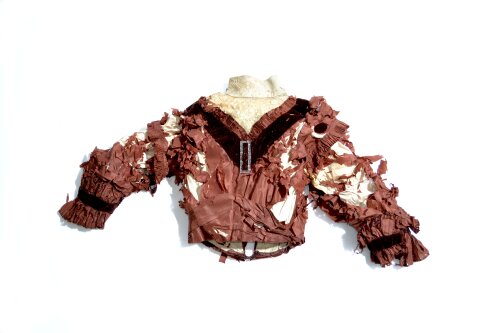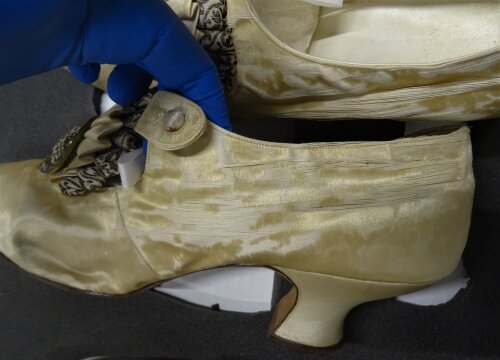SAFESILK: Understanding, preventing and treating metal salt-induced silk degradation in heritage collections
Manufacture of textiles, including both production and dyeing of fabrics, has been one of Western Europe most important industrial sectors since the Middle Ages, and has played a key role in its history of technology.1 This is mirrored in the vast amount and variety of textile objects now present in heritage collections.
Starting in the 19th century, adding metal salts to silk textiles, aiming to make the fabric heavier and thicker, became common practice in Europe and North America, this process is referred to as silk weighting or loading.2 Nowadays such weighted silks are considered some of the most rapidly degrading materials in heritage collections, with objects often falling apart, as shown in Figures 1-3.3

Figure 1 : Corsage (ST81124AB) from MoMu study collection, dated 1880-1900. The brown silk is breaking into pieces, showing the white cotton lining underneath. Amber Tillemans CC BY. Available at ST81124AB · Studiecollectie · SBS MoMu (libis.be)
Although recognised as a big problem, this issue is still understudied and to date no successful conservation treatments have been found.

Figure 2: Shoe (T12/1374AB/S18), from MoMu collection, dated 1910-1920. As the silk weft threads degrade the warp cotton threads become visible.The SAFESILK project (FWO project G060422N) aims to understand the mechanism of metal salt-induced silk degradation and any factors influencing it, with the goal to prevent such process from happening in the first place and to find an effective treatment for the damaged pieces.
Figure 3: Close up of the damaged, shattering silk from a hat (AF6117) in the MoMu collection, dated 1860-1870.
The project is funded by the Research Foundation – Flanders (FWO) and the Slovenian Research Agency (ARRS), project N1-0250 and programme P6-0283 through the WEAVE programme. The project involves ARCHES at the University of Antwerp and the Heritage Science Laboratory at the University of Ljubljana, and is in partnership with the Antwerp Fashion Museum (MoMu) and the National Museum of Slovenia (NMS).
[1] Mokyr, J., The gifts of Athena: Historical origins of the knowledge economy. 2002, Princeton: Princeton University Press.
[2] N. Luxford, PhD Thesis, University of Southampton, 2009, 2.
[3] M. Hacke, Studies in Conservation 53(sup2), 2008, 3.